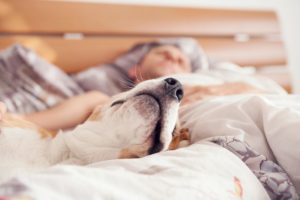Can Dogs Have Sleep Apnea?
Sleep apnea can occur in dogs, especially in breeds like English bulldogs, French bulldogs, chihuahuas, pugs, and Cavalier King Charles spaniels. Symptoms of sleep apnea in dogs appear to be similar to those experienced by humans with sleep apnea. However, there is not a formal classification system for sleep apnea and other sleep disorders in dogs.
Learning about sleep apnea in dogs can help you recognize the signs and decide whether you should alert your veterinarian to any changes in your dog’s sleep patterns or overall health.
How Common is Sleep Apnea in Dogs?
Sleep apnea is likely rare in most dogs. However, in brachycephalic dog breeds , sleep apnea and other sleep-disordered breathing can be quite common.
Brachycephalic dog breeds have snouts that are relatively short compared to the size of their head. Breeds such as pugs and bulldogs have extreme brachycephaly , which gives them the characteristic squished face look that many people find endearing.
Surveys reveal that a significant number of dogs with brachycephaly experience breathing problems during sleep . The shorter the snout relative to the rest of the face, the more likely a dog is to experience breathing problems, although dogs with only moderately short snouts can also have sleep apnea.
Symptoms of Sleep Apnea in Dogs
A dog with sleep apnea may visibly struggle to breathe while they sleep . The most salient sleep apnea symptom in dogs is the presence of apneas and hypopneas, which are pauses in breathing that last approximately 15 to 20 seconds. Other characteristic sleep apnea symptoms in dogs include:
- Noisy breathing
- Gasping or choking
- Pauses in breathing
- Snoring
- Frequently waking up struggling to breathe
- Mouth breathing
- Adopting sleep positions designed to open the airway, like sitting up or holding a toy in the mouth
- Lethargy or daytime sleepiness
Symptoms may occur on and off during sleep. Sleep apnea symptoms in dogs tend to worsen during rapid eye movement (REM) sleep when the airway muscles relax.
Researchers use a modified version of the human obstructive sleep apnea (OSA) diagnostic criteria when studying sleep apnea in dogs. To qualify for a sleep apnea diagnosis, the dog must experience more than five apneas or hypopneas along with at least one additional symptom.
Potential Causes of Sleep Apnea in Dogs
Just like obstructive sleep apnea in humans, obstructive sleep apnea in dogs can occur when internal structures in the nose and throat physically block the airway. These physical obstructions can occur due to obesity, age, or natural variations in facial features.
Brachycephaly
Several features common to brachycephalic dogs make them more likely to experience breathing difficulties. These dogs often have narrow nostrils and abnormalities in internal nasal structures, making it hard to breathe through the nose. Moreover, although they have shorter snouts, brachycephalic dogs still have large tongues, tonsils, and other internal structures.
The resulting buildup of soft tissue in the airway further obstructs breathing and can lead to ongoing problems known as brachycephalic obstructive airway syndrome (BOAS). This is similar to what happens with obstructive sleep apnea in humans.
Researchers often consider sleep apnea in brachycephalic dogs to be a continuation of BOAS, caused by the same airway anomalies. During sleep, muscles relax and leave even less space for air to pass through.
Obesity
Dogs with obesity may be more likely to experience symptoms of sleep-disordered breathing. Obesity in dogs is associated with more severe symptoms of brachycephalic obstructive airway syndrome, and obesity in humans is also linked to obstructive sleep apnea.
It is difficult to say whether obesity is a cause or a result of breathing difficulties in dogs. On the one hand, the extra tissue itself may contribute to airway narrowing. On the other hand, dogs who have trouble breathing are also more likely to be overweight since it is difficult for them to exercise.
Even for dogs who are not overweight, having a thicker neck may contribute to breathing problems for dogs, as it does in humans. For dogs who are already at risk of breathing difficulties, a thicker neck places more pressure on the airway, making it more likely to close.
Age
Sleep apnea symptoms are often worse in older dogs . Over time, repeated inflammation and pressure changes can irritate the airway and alter the shape of the soft tissues, causing the airway to become even smaller.
Allergies
Allergies that inflame the nasal passages can worsen sleep-disordered breathing in humans, and some experts believe allergies may also play a role in canine sleep apnea . However, allergies are not likely to be the principal cause of sleep apnea in dogs.
Is Sleep Apnea in Dogs Dangerous?
Just as in humans, dogs with sleep apnea may face a higher risk of high blood pressure and cardiovascular disease in the long term.
Lapses in breathing from sleep apnea disrupt both sleep continuity and blood oxygen levels. These constant fluctuations in the amount of oxygen in a dog’s bloodstream can lead to unwanted health consequences if apnea is left untreated.
Sleep Apnea Treatment for Dogs
For many dogs, surgery may help improve sleep apnea symptoms by clearing structures in the nose and throat that are blocking the airway. The type of surgery depends on the individual dog, as there are multiple structures that can interfere with breathing.
Researchers are also studying whether medication might help control canine sleep apnea . Drugs that block the action of serotonin during REM sleep may be especially useful for sleep apnea in dogs.
The gold standard for OSA treatment in humans is continuous positive airway pressure (CPAP) therapy, in which the user wears a mask that delivers steady airflow to keep the throat open. So far, no CPAP devices have been approved for use in pets.
Dog owners who notice signs of sleep apnea in their pets should take note of the symptoms and discuss them with their veterinarian, especially if the dog is from a brachycephalic breed. Although several popular dog breeds have brachycephaly, it should not be considered normal for dogs to have breathing problems. Dog owners who notice any symptoms of BOAS, such as snoring or loud breathing, should talk to a vet for options to help improve their pet’s quality of life.
For dogs with brachycephaly, taking shorter walks and avoiding the hottest parts of the day may help minimize breathing problems. Maintaining a healthy body weight can also help minimize sleep apnea symptoms.

Still have questions? Ask our community!
Join our Sleep Care Community — a trusted hub of sleep health professionals, product specialists, and people just like you. Whether you need expert sleep advice for your insomnia or you’re searching for the perfect mattress, we’ve got you covered. Get personalized guidance from the experts who know sleep best.
References
8 Sources
-
Toth, L. A., & Bhargava, P. (2013). Animal models of sleep disorders. Comparative Medicine, 63(2), 91–104.
https://pubmed.ncbi.nlm.nih.gov/23582416/ -
Packer, R. M., Hendricks, A., Tivers, M. S., & Burn, C. C. (2015). Impact of Facial conformation on canine health: Brachycephalic obstructive airway syndrome. PloS One, 10(10), article e0137496.
https://pubmed.ncbi.nlm.nih.gov/26509577/ -
Mondino, A., Delucchi, L., Moeser, A., Cerdá-González, S., & Vanini, G. (2021). Sleep disorders in dogs: A pathophysiological and clinical review. Topics in Companion Animal Medicine, 43, 100516.
https://pubmed.ncbi.nlm.nih.gov/33556640/ -
Hinchliffe, T. A., Liu, N. C., & Ladlow, J. (2019). Sleep-disordered breathing in the Cavalier King Charles spaniel: A case series. Veterinary Surgery, 48(4), 497–504.
https://pubmed.ncbi.nlm.nih.gov/30592314/ -
Mitze, S., Barrs, V. R., Beatty, J. A., Hobi, S., & Bęczkowski, P. M. (2022). Brachycephalic obstructive airway syndrome: Much more than a surgical problem. The Veterinary Quarterly, 42(1), 213–223.
https://pubmed.ncbi.nlm.nih.gov/36342210/ -
Kopke, M. A., Wightman, P., & Ruaux, C. G. (2019). Obstructive sleep apnea in a Chihuahua successfully managed with ondansetron. Clinical Case Reports, 7(5), 872–876.
https://pubmed.ncbi.nlm.nih.gov/31110706/ -
Villedieu, E., Robinson, W., & Shales, C. (2022). Suspected obstructive sleep apnea successfully treated with ondansetron in a pug. Journal of the American Animal Hospital Association, 58(3), 152–155.
https://pubmed.ncbi.nlm.nih.gov/35576395/ -
Packer, R. M., & Tivers, M. S. (2015). Strategies for the management and prevention of conformation-related respiratory disorders in brachycephalic dogs. Veterinary Medicine (Auckland, N.Z.), 6, 219–232.
https://pubmed.ncbi.nlm.nih.gov/30101109/







